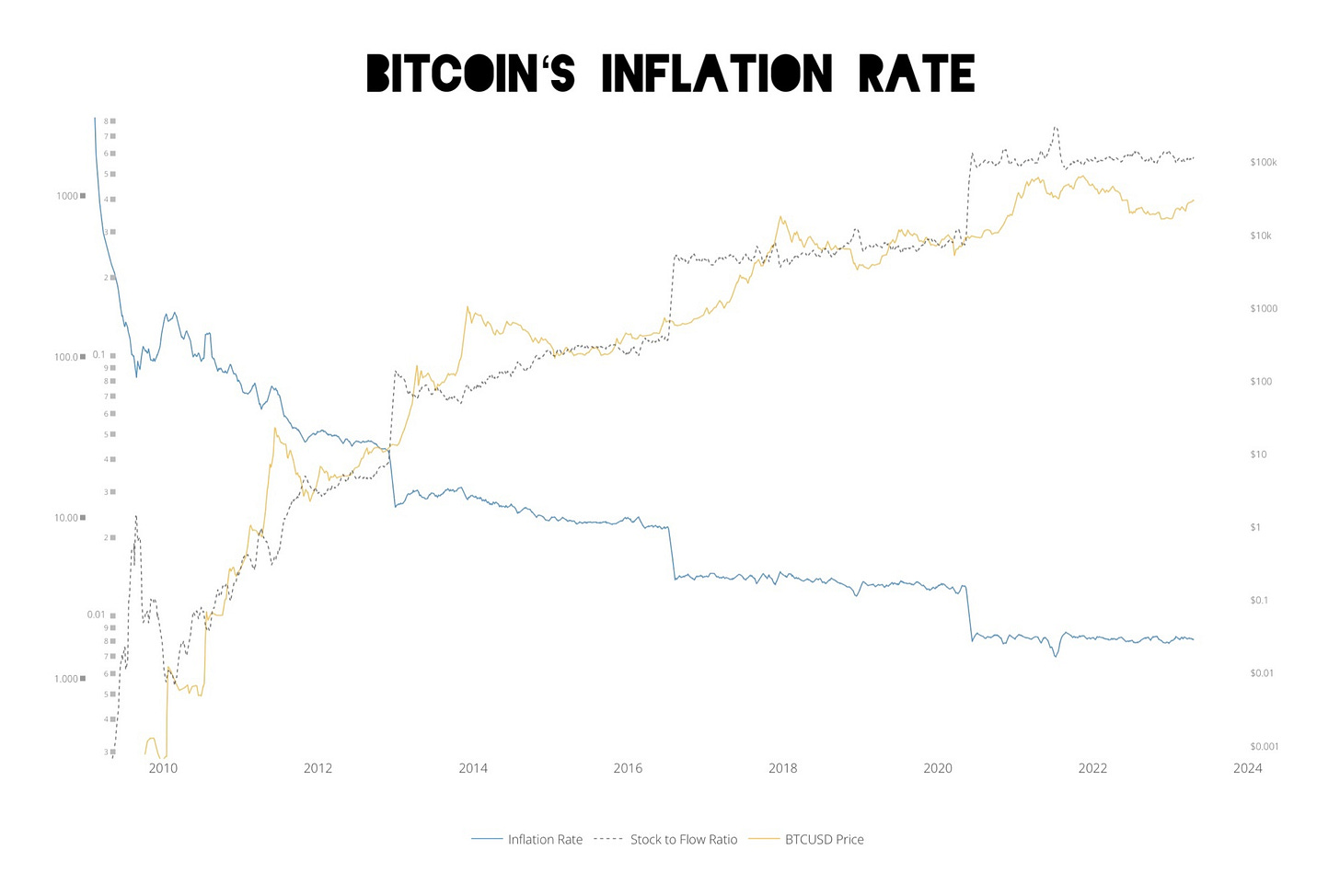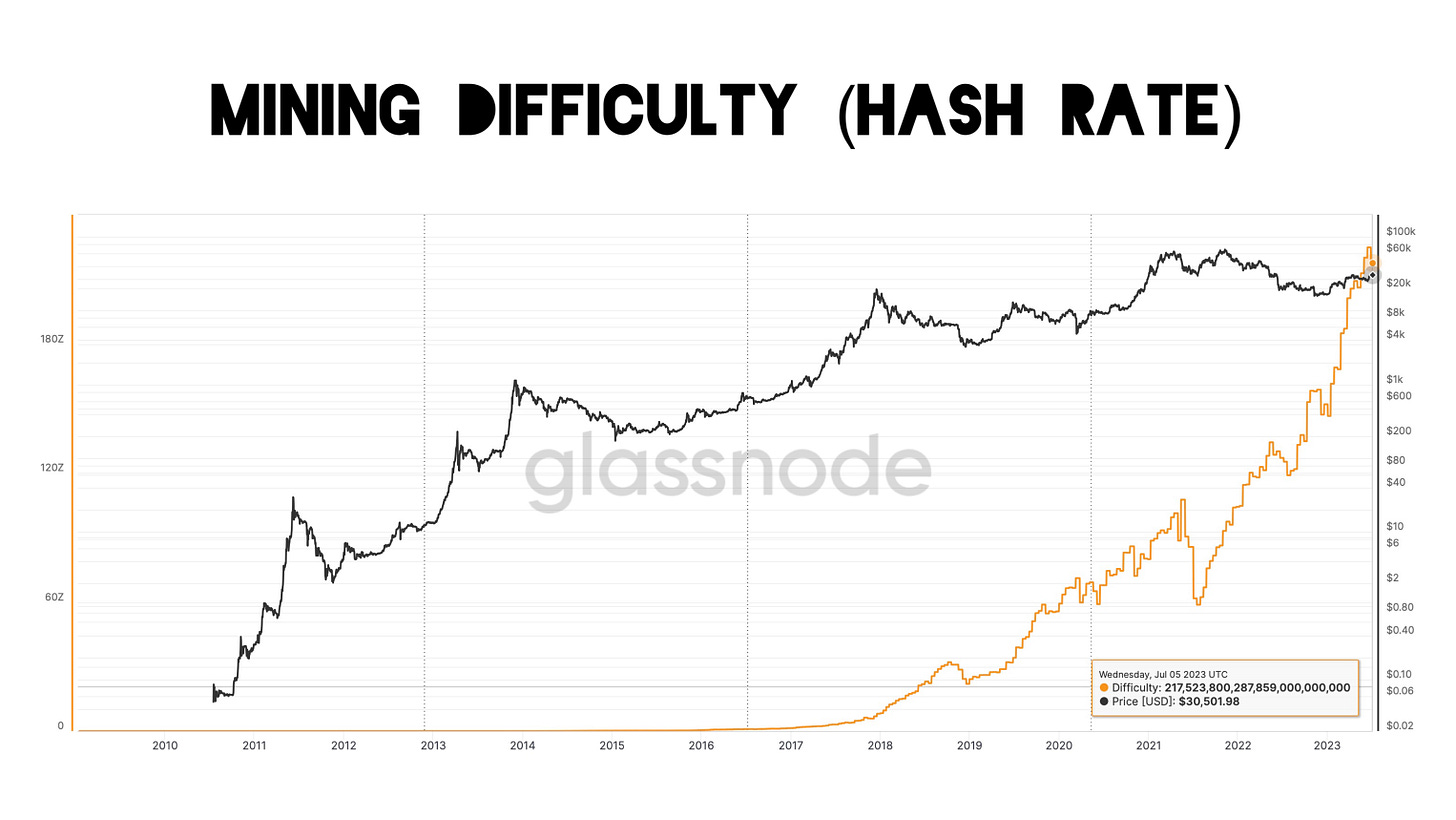Valuing Bitcoin
Episode XI. Block height: 798000. Focusing on long term signal instead of short term noise: Bitcoin metrics you should know.
Bitcoin, as a public open source blockchain, enables it to be analyzed like no other asset. We don’t need to rely on information from third parties, because we can just take a look at the Bitcoin Code or On-Chain data. When analyzing Bitcoin and its value compositions, I look at three different layers: Network Health, Growth, Speculation.
In this episode, we look at the health and growth layers of Bitcoin, both long-term indicators of how properly the network is functioning and how fast adoption is growing, cutting out the unnecessary short-term bullshit on which mainstream media is mainly focusing. Therefore, this is not a ‚Bitcoin goes to the moon tomorrow’ article but about the underlying fundamentals of Bitcoin’s value compositions, so let’s dive in.
Monetary policy
Circulating Supply
Total circulating supply is a function of historical monetary metrics and the daily issuance associated with current monetary policy. From Bitcoin’s inception, monetary policy has been pre-determined and encoded in its protocol, making it predictable and verifiably. Only 21 million Bitcoin FOREVER, Laura.
Currently, 19,426,437 Bitcoin are in circulation, which represents 92.4% of the total supply. The remaining 7.6% will be issued over the next 118 years. Yes, you read that right: The last Bitcoin will be mined in the year 2140! Bitcoin’s strict adherence to a rules-based monetary policy highlights its integrity.
Inflation Rate
Furthermore, Bitcoin‘s inflation rate, the issuance of new coins to the circulating Bitcoin supply is also encoded. Unlike fiat currencies, which can be printed at will, the new Bitcoin supply is pre-determined and halves every 210,000 blocks (roughly 4 years). Currently, Bitcoin has an inflation rate of 1.74%, comparable to that of Gold. The next halving occurs in April 2024, making Bitcoin much scarcer than most other assets.
Bitcoin Nodes
Each full node has the entire Bitcoin blockchain stored, thus another node means another copy of the Bitcoin ledger and a further distribution of the Bitcoin code. The more individual copies exist and the wider those copies are spread around the globe, the harder it is to turn Bitcoin off: 43,668 Bitcoin nodes (reachable and unreachable) are running around the globe right now.
Running your own node is at least as important as holding your own Bitcoin keys. It is also much easier than many think. Check out my step-by-step guide here ‚Don‘t trust, verify‘, and run your own Bitcoin full node now.
Hash Rate
Bitcoin’s security is guaranteed by miners, who ensure transactions are verified and irreversible. Mining hash rate is therefore a key security metric for Bitcoin. The greater the levels of hashing power, the harder it is for someone to overpower and attack the network. Thus, all else equal, rising hash rate increases security.
Since 2010, the hash rate has increased at four orders of magnitude higher than that of price. As a result of advancement in hardware and miner’s willingness to invest in the expectation of Bitcoin’s price appreciation over time. Very bullish.
S - Curve Adoption
The S - Curve breaks global adoption into stages along the growth cycle. It is a term used to define a sociological framework that demonstrates how different people ranging in demographics and psychological characteristics adopt and react to new technologies and innovative products. In this concept, most of the growth occurs during the early and late majority stages. In other words: You are still early.
Market Cap Ratio
Bitcoin’s market cap sits currently at roughly 600 billion USD, a tiny, insignificant little spot in all the world’s money and markets, which exceeds 1.3 quadrillion USD (A number with fifteen zeros!). Thus, Bitcoin is currently valued at 0.00046153846 per cent, despite being one of a few assets without any counterparty risk. This will be an essential feature once our debt based fiat system collapses, which is inevitable looking at current debt levels.
HODL Waves
HODL Waves divides the total circulating supply of the Bitcoin network into holding period bands. The 1-to-2-year HODL wave, for example, measures the percentage of Bitcoin that transacted between one and two years. Short term age bands rise dramatically during periods of market exuberance and the 3y-5y band rises during major market downturns, signaling very healthy hodling behavior at the moment.
Personal Bitcoin Stack
And last but not least, the most important metric of them all. Your own Bitcoin stack, that is hopefully growing over time: DCA matters.
The End
That's it for this episode. I hope you gathered some valuable knowledge from this one. Keep stacking and focus on the fundamentals.
Thanks for reading and remember: ₿ critical, ₿ informed, ₿ prepared. Yours,
B informed
[VIII] The Bitcoin Retirement Plan
Education for everyone
No pay walls. No sponsored articles. Just pure, independent and free education. If you truly want to support my work, you can donate Sats via lightning. Cheers!
Recommended Hardware - Wallet
F* Ledger! Read everything about Bitcoin Self-Custody in my episode ‘Take back control over your Bitcoin, now’ and get yourself a proper hardware wallet: Shiftcrypto’s The Bitbox Bitcoin only is my favorite. Swiss made, Great customer support and worldwide shipment.
Education is key
[1] Andreas Antonopoulos, Mastering the Lightning Network
[2] Saifedean Ammous, Principles of Economics
[3] Ayn Rand, Atlas Shrugged
[4] Edward Chancellor, The Price of Time
[5] Ryan Holiday, The Obstacle is the Way












